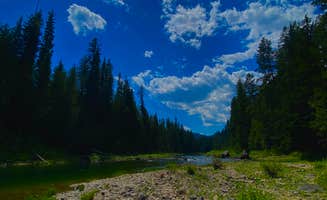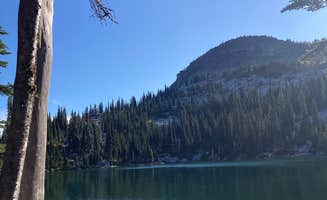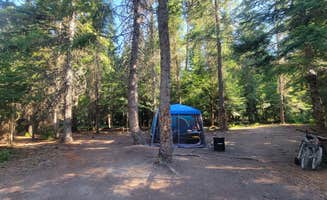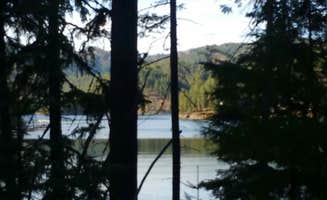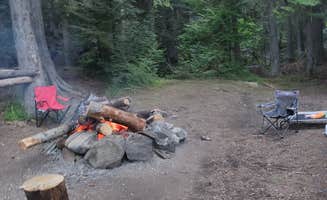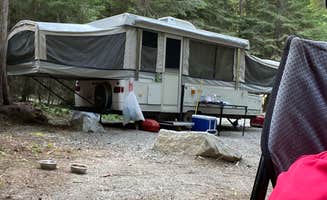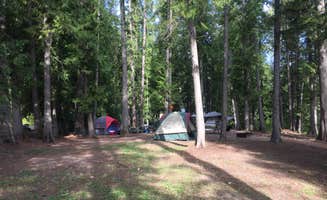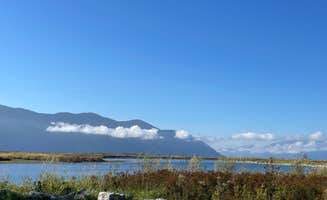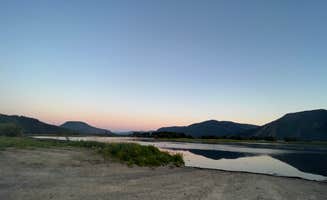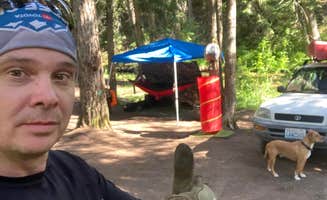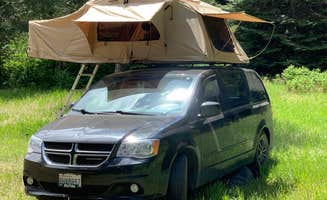Dispersed camping near Coolin, Idaho offers primitive sites throughout the Kaniksu National Forest at elevations ranging from 2,400 to 5,700 feet. Most locations sit within mixed conifer forests characteristic of the northern Idaho panhandle region. Summer temperatures average 75-85°F during the day and 45-55°F at night, with frequent afternoon thunderstorms in July and August requiring adequate shelter and rain gear.
What to do
Fishing opportunities: Pack River Dispersed Site provides creek access where campers report catching small trout during summer months. According to Emma T., it offers a "very peaceful" riverside setting, though visitors should note the "lots of washboard/rutted sections on the road" when planning access.
Creek exploration: At North Fork Chewelah Creek, families can enjoy water activities even without swimming. One visitor explained, "If you have a tube bring it and enjoy a short river ride. Not a good place to fish. The main camp area is completely shaded keeping things cool."
Backcountry hiking: The area surrounding Beehive Lake Dispersed offers alpine hiking opportunities. A camper warns the trail is "pretty strenuous, with some tough climbs along the way. The trail itself isn't well marked, so you'll want to pay close attention or bring a good map to avoid getting off course."
Huckleberry picking: Seasonal foraging opportunities exist throughout the forest areas, particularly in late summer. Beehive Lake visitors report finding "huckleberries everywhere, which is a sweet bonus after the tough hike in" during the right season, typically late July through August.
What campers like
Riverside solitude: Campers at Pack River Dispersed Site appreciate the isolation. One reviewer noted it's "good for horses, camping and solitude," making it ideal for those seeking to avoid crowds common at developed campgrounds.
Wildlife viewing: The forests around Coolin provide habitat for diverse wildlife. At North Fork Chewelah Creek, a camper reported, "Hearing the birds was really cool," while another mentioned, "The only animal I saw besides squirrels and birds was a skunk. Bears, coyotes, wolves and cougars are known to frequent the area."
Alpine settings: Higher elevation sites offer unique environments. Near Beehive Lakes, Matt S. found an "awesome single site adjacent to the Beehive Lakes trailhead parking lot," providing direct access to alpine terrain not available at lower elevations.
Creek sounds: The natural white noise from flowing water enhances the camping experience. At Cee Cee Ah Creek, Joe B. appreciated how "there is a creek that runs through this area, which is great for cooling off on hot days."
What you should know
Road conditions: Access to dispersed sites requires careful driving. At Pack River, Emma T. warned about "lots of washboard/rutted sections on the road and some steep areas getting to certain campsites."
Bear safety: Bears are active throughout the region. At Sullivan Creek, Jeanna A. reported "a late night bear visitor" and Marcus K. noted that bear boxes are provided at some sites, indicating the need for proper food storage.
Site navigation: Finding exact locations can be challenging. Naomi C. advised about North Fork Chewelah Creek: "At first I entered the coordinates listed on the page and it took me to the opposite entrance to Colville National Forest... Make sure you follow the written directions - just follow Sand Canyon all the way out."
Limited facilities: Free camping near Coolin means self-sufficiency. At Sullivan Creek, Marcus K. noted "make sure to bring the appropriate toilet supplies" for sites without bathrooms, and "firewood is not provided so make sure to purchase prior and/or bring a ax to cut up the wood that has been left behind."
Tips for camping with families
Swimming spots: Cooks Lake offers family-friendly water access. Jennifer R. mentioned, "Cute little dispersed campground approx 6 sites. At least 2 of them are good for me trailer although I wouldn't try if you're not experienced with towing."
Site selection: For families, choosing the right site matters. At Cooks Lake, Allyson A. detailed, "There is another steep entrance to this beach at the other end, from a pullout on the road above... there was one spot that was level enough for a tent...there was 12" of beach between the tent and the water!"
Activity preparation: Pack appropriate gear for water activities. At North Fork Chewelah Creek, a visitor shared: "If you have a tube bring it and enjoy a short river ride. Not a good place to fish."
Wildlife education: Use camping as a learning opportunity. One camper at North Fork Chewelah Creek described seeing "squirrels and birds... tadpoles and turtles and little water snakes," making for natural science lessons for children.
Tips from RVers
Clearance considerations: Most dispersed sites require vehicles with adequate ground clearance. At Campbell Park, facilities are more accessible, with Ryan C. noting it has "around 10 sites with free firewood, washrooms, drinking water and a small lagoon for swimming."
Site sizing: RV campers should research space limitations. At Cooks Lake, Jennifer R. advised, "At least 2 of them are good for me trailer although I wouldn't try if you're not experienced with towing."
Weather preparation: Seasonal conditions affect RV accessibility. A Cooks Lake visitor warned, "Beware of mud!" explaining they "found myself barely on the edge of lake bottom mud. Didn't get out till the next morning."
Amenity planning: RVers need to plan for limited services. Jennifer R. noted the Sullivan Creek area "has one vault toilet that was pretty clean but bring your own tp," highlighting the need for self-sufficiency even at sites with minimal facilities.


